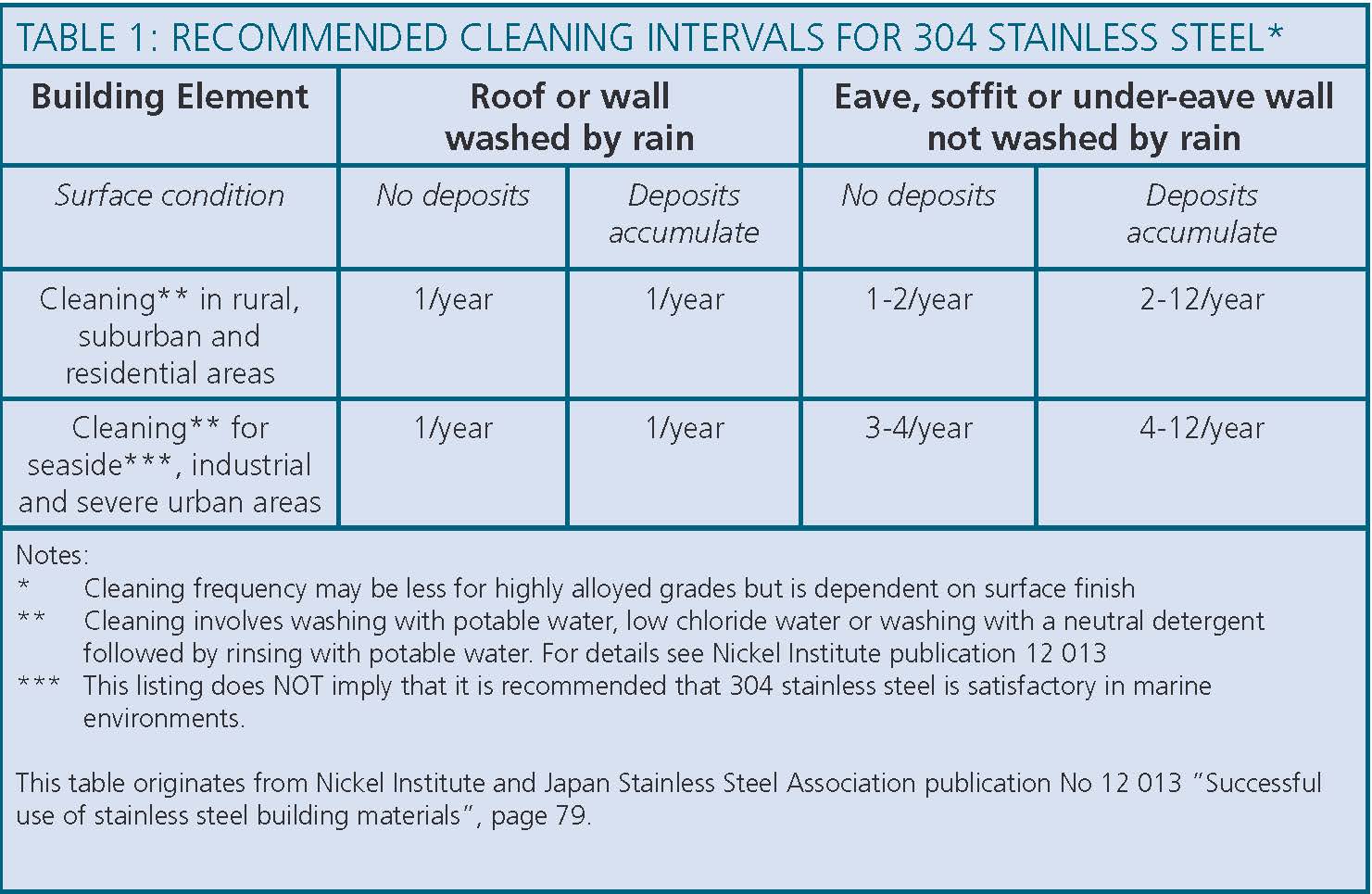What is tea staining? How often do I clean stainless steel? How do I get rid of imperfections?
These are just a few of the most common questions we are asked.
The Australian Stainless Steel Development Association (ASSDA) has a very helpful article on their website answering these great questions and more. Miami Stainless has been a member of this highly respected and accredited association for many years and uses ASSDA as trusted source of information. Go here to view the full article.
What is tea staining?
Tea staining is discolouration of the surface of stainless steel by corrosion. It is a cosmetic issue that does not affect the structural integrity or the lifetime of the material. Tea staining occurs most commonly within about five kilometres of the surf and becomes progressively worse closer to the marine source.
However, wind exposure, pollution levels, local sheltering and higher temperatures can create environments where tea staining might occur 20 kilometres or more from the surf. The effect is much less severe around sheltered bays. These same factors also increase corrosion rates of alternative materials.
Other causes of staining that are not tea staining include carbon steel contamination, uncleaned welds and chemical fumes such as hydrochloric acid or bleach.
Why does tea staining occur?
The relationships between the contributing factors are complex, but generally become increasingly critical closer to salty water. Tea staining occurs when local conditions (such as temperature, relative humidity and presence of corrosive substances on the surface) are too aggressive for that stainless steel grade in its installed condition.
There are important factors that promote the occurrence of tea staining that should be considered, as shown in the box and explained below.
1. Presence of corrosive substances
The presence of sea salt on the surface of the stainless steel is one of the major factors that causes tea staining. Sea salt has the characteristic of staying wet until a very low relative humidity (RH). The result of this is that the surface stays wet (and is corroding) longer with sea salt compared with sodium chloride. However, presence of industrial pollutants could also make the conditions more aggressive.
2. Atmospheric conditions
A combination of atmospheric conditions with high humidity (eg tropical climates) and a high temperature creates worse conditions for the occurrence of tea staining. The high humidity generates a film of moisture that dissolves the salt deposits and creates a corrosive solution on the surface. The low humidity and absence of corrosive deposits means that tea staining is rarely a problem indoors.
3. Surface orientation and design
Poor drainage promotes corrosion whether it is because the surface is near horizontal or has a texture that traps contaminants. Conditions are very aggressive in rain sheltered areas such as the underside of sloping roofs, downpipes under eaves or in a building rain shadow. These can cause significant tea staining. Designs with corners or crevices (such as intermittent welds) can trap water and lead to more serious corrosion than tea staining.
4. Surface roughness
Deep grooves or metal folds on a surface are more susceptible to corrosion because they can trap salts (chlorides). When the surface dries the salts become concentrated, making the conditions more aggressive. A deep groove will have more trapped water (and salts) so the bottom of the groove will be exposed to salt concentration above its resistance for longer - which will initiate corrosion. There is a critical surface roughness of approximately 0.5 μm Ra for cut or abraded surfaces. Abraded surfaces smoother than approximately 0.5µm Ra are much less susceptible to corrosion.
5. Surface characteristics
To achieve the best corrosion performance of a stainless steel, the surface should be clean, free of contamination such as carbon steel swarf or manganese sulphide inclusions, and have a continuous passive layer. Acid pickling, acid passivation or electropolishing for sufficient time will remove these contaminants from the surface as well as restore the passive layer, leaving the stainless steel with a clean and corrosion resistant surface. If a stainless steel is welded, the heat input will locally destroy the passive layer (a dark non-protective oxide is formed around the weld). To achieve best corrosion performance and restore passivity of the weld, the heat tint and underlying chromium depleted layer must be removed. How this is done is described later.
6. Appropriate grade
There are several hundred grades of stainless steel with different chemical composition but only about 10 in common use. All owe their corrosion resistance to the thin chromium oxide film on the surface, although other additions such as molybdenum and nitrogen can improve the corrosion resistance, especially in chloride-containing environments. A formula based on the content of these three elements is useful to rank the corrosion resistance of different grades. This Pitting Resistance Equivalent [PRE] number is calculated by %Chromium + 3.3 %Molybdenum + 16 %Nitrogen. The PRE ranges from 10.5 for the grades with the lowest corrosion resistance to more than 40. For acceptable corrosion resistance, typically a PRE of approximately 18 is adequate away from marine influences, PRE of approximately 24 is required for marine atmospheres while severe marine atmospheres may require PRE of approximately 34. The higher the PRE, the greater the corrosion resistance.
7. Maintenance
Stainless steel is a low maintenance material but it is not generally maintenance free. A light and regular wash is best and natural rain washing may be sufficient. If not, then consider washing the stainless steel when you wash an adjacent window. Lower grades will require more regular maintenance and if the environment causes sticky deposits, a solvent and detergent mix may be required. Application of oils or waxes will temporarily restrict chloride access to the stainless steel but they need regular renewal. These temporary protectives also tend to attract debris and dull the surface.
How to reduce the risk of tea staining.
1. Absence of corrosives - especially salt.
2. Atmospheric conditions - lower temperatures and low relative humidity (RH) are better.
3. Surface orientation and design - free drainage and avoidance of traps which can concentrate corrosives. This includes open exposure to allow rain washing.
4. Surface roughness - smoother is better.
5. Chemical cleanliness or passivation of the surface improves the corrosion resistance.
6. Appropriate grade for exposure conditions - increasing PRE increases corrosion resistance.
7. Maintenance - or corrosives will accumulate.
Stainless Steel Handling
Design, fabrication and handling
Poor design and fabrication can lead to tea staining or more serious corrosion of stainless steels. Surfaces should be free draining, boldly exposed to rain washing and avoid channelling of run-off. Horizontal surfaces or curves which cause ponding are specific problems. Abraded surfaces should not be rougher than 0.5µm Ra and the grain should be vertical to avoid ponding and collection of contaminants. For abraded surfaces, the best corrosion resistance will be achieved if a nitric acid passivation treatment is carried out as a final step.
Competent stainless steel fabricators will avoid carbon steel contamination (which can cause other corrosion problems), so choose designers and fabricators that are experienced with stainless steel to achieve the best outcome.
Appropriate grade selection
Each stainless steel has a limit to the concentration of salts that it can comfortably resist: the higher the alloying content (Cr, Mo and N), the higher the resistance to corrosion. Exposure of a particular grade of stainless steel to a more aggressive environment than it can resist will cause tea staining.
Grade 316, or a grade with equivalent corrosion resistance, should be selected as a minimum within five kilometres of the surf. For critical applications (eg splash zones, unwashed areas or rough surfaces), higher grades of stainless steel such as duplex or ‘super’ grades may be required.
The lower alloyed and less expensive grades (such as 304 or 430) will probably become tea stained or even suffer more severe corrosion in a marine environment.
Installation and Inspection
After installation, the completed structure should be visually inspected for surface damage or contaminants. If contamination is suspected, several cycles of a misting and drying test with tap water is relatively simple. The sensitive ferroxyl test (described In ASTM A380) may also be used in critical applications. If discovered, imperfections should be removed and the corrosion resistance chemically restored by pickling or passivating treatments or by electropolishing.
Do not use hydrochloric acid.
Hydrochloric acid, sometimes used to clean cement or mortar residues, must not be used on stainless steel — it will stain the surface and usually start more serious corrosion.
Design Recommendations
Environment
Tea staining is most likely to occur up to five kilometres from a surf beach and one kilometre from still marine waters. There is no hard and fast rule: wind and weather conditions play a big part and the severity of the conditions increases sharply as you approach the surf. AS 2312 suggests that in some special circumstances, 20 kilometres from the coast can still constitute a marine environment. The closer to the source of salt, the more critical it is to follow the recommendations in this Bulletin.
Areas that are sheltered or not rain washed are particularly susceptible. Tropical and high humidity areas are also more at risk of tea staining.
Specify and Insist on the Right Grade
In marine environments, use grade 316 or one with equivalent corrosion resistance unless the job is aesthetically critical and regular maintenance is unlikely. Where there are high aesthetic expectations a number of more corrosion resistant stainless steel grades can be considered. The first step up from 316 is 2205 and then the super duplex grades, although the high molybdenum austenitics and high molybdenum ferritics may also be useful. Smooth surface finish and maintenance are still important with these grades.
Regular Maintenance
Washing removes deposits (such as salt) that can cause corrosion. It is necessary to avoid tea staining. Rain washing the surface is helpful in reducing tea staining, so design the job to take advantage of the rain, but ensure good and even drainage. Stipulate that the stainless steel also be washed when cleaning of the surrounding area takes place. As a guide, stainless steel should be washed if a window requires washing. For best results, wash with soap or mild detergent and warm water followed by rinsing with clean cold water. The appearance of the surface can be improved further if the washed surface is wiped dry.
If routine cleaning of the surrounding area does not take place, washing frequency for the stainless steel is recommended as in Table 1 below.
It is essential that abrasive cleaners or those containing chlorides or bleach are NOT used to clean stainless steels as they will damage the surface. If some tea staining does occur, then an assessment of the 7 points is required to determine why the problem occurred. Simple mechanical polishing is unlikely to both remove current and prevent future teastaining. Reasonably simple chemical cleaning and passivation is usually the most effective treatment.



